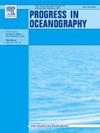Pre-molt dispersal and use of marine protected areas by Southern Rockhopper Penguins (Eudyptes chrysocome) at the southernmost oceanic regions of South America
IF 3.8
3区 地球科学
Q1 OCEANOGRAPHY
引用次数: 0
Abstract
Marine Protected Areas (MPAs) are crucial for conserving marine biodiversity, and assessing the effectiveness of boundaries in protecting marine species is essential. In the Southwest Atlantic Ocean, four MPAs have been created. In this study we evaluate the use of these MPAs by Southern Rockhopper Penguins (Eudyptes chrysocome) that nest at Isla de los Estados, Argentina during the pre-molt period in February and March 2020 by combining geolocation sensor data and spatial analysis together with stable isotopes analysis (δ13C and δ15N) to assess their spatial and trophic niches. We recaptured 16 of 25 adults to which loggers had been attached (64 % recapture rate, 6 females and 10 males). Penguins dispersed mainly southward and used the MPAs as corridors towards feeding area such as the Antarctic Polar Frontal Zone (APFZ). We found no evidence of sex-specific spatial and trophic niche partitioning. To develop robust conservation strategies, future studies should span multiple years and enhanced sampling effort to comprehensively explore the pre-molt trophic ecology and at-sea distribution of Southern Rockhopper Penguins.
南美洲最南端大洋区域的南石斑企鹅(Eudyptes chrysocome)蜕皮前的扩散和对海洋保护区的利用
海洋保护区(MPA)对于保护海洋生物多样性至关重要,评估保护区边界在保护海洋物种方面的有效性也至关重要。在西南大西洋,已经建立了四个海洋保护区。在本研究中,我们结合地理定位传感器数据和空间分析以及稳定同位素分析(δ13C 和 δ15N),评估了筑巢于阿根廷洛斯埃斯塔多斯岛的南石斑企鹅(Eudyptes chrysocome)在 2020 年 2 月和 3 月蜕皮前期对这些 MPA 的使用情况,以评估它们的空间和营养龛位。我们重新捕获了贴有记录仪的 25 只成年企鹅中的 16 只(重新捕获率为 64%,其中 6 只为雌性,10 只为雄性)。企鹅主要向南散布,并将海洋保护区作为通往南极极地前缘区(APFZ)等觅食区的走廊。我们没有发现性别特异性空间和营养生态位分区的证据。为了制定强有力的保护策略,未来的研究应跨越多个年份,并加强采样工作,以全面探索南石斑企鹅蜕皮前的营养生态学和海上分布。
本文章由计算机程序翻译,如有差异,请以英文原文为准。
求助全文
约1分钟内获得全文
求助全文
来源期刊

Progress in Oceanography
地学-海洋学
CiteScore
7.20
自引率
4.90%
发文量
138
审稿时长
3 months
期刊介绍:
Progress in Oceanography publishes the longer, more comprehensive papers that most oceanographers feel are necessary, on occasion, to do justice to their work. Contributions are generally either a review of an aspect of oceanography or a treatise on an expanding oceanographic subject. The articles cover the entire spectrum of disciplines within the science of oceanography. Occasionally volumes are devoted to collections of papers and conference proceedings of exceptional interest. Essential reading for all oceanographers.
 求助内容:
求助内容: 应助结果提醒方式:
应助结果提醒方式:


